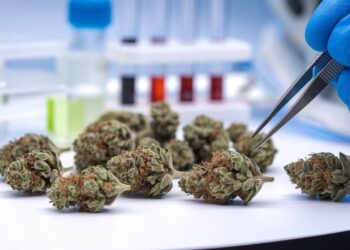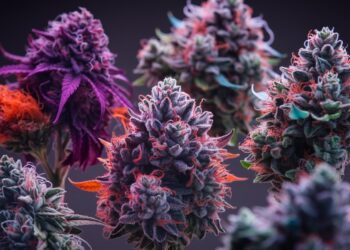You’ve probably noticed those shiny crystals on your cannabis buds, the frosty, sparkly layer that almost looks too pretty to touch. But here’s the real question: do those crystals mean your weed is high quality?
Those crystals are called trichomes, and they’re more important than they look. They hold the THC, CBD, and aromatic terpenes that shape your cannabis experience. But not all crystal-covered buds are created equal. Some crystal-heavy buds may still fall short when it comes to actual quality.
Over the years, I’ve tested and compared dozens of strains, learning to spot the difference between high-quality and average weed just by looking at the trichomes. In this article, I’ll break down what those crystals tell you. You’ll learn how to spot signs of freshness, potency, and even poor growing practices, so you can buy smarter and smoke better.
Understanding THC Crystals on Cannabis Buds
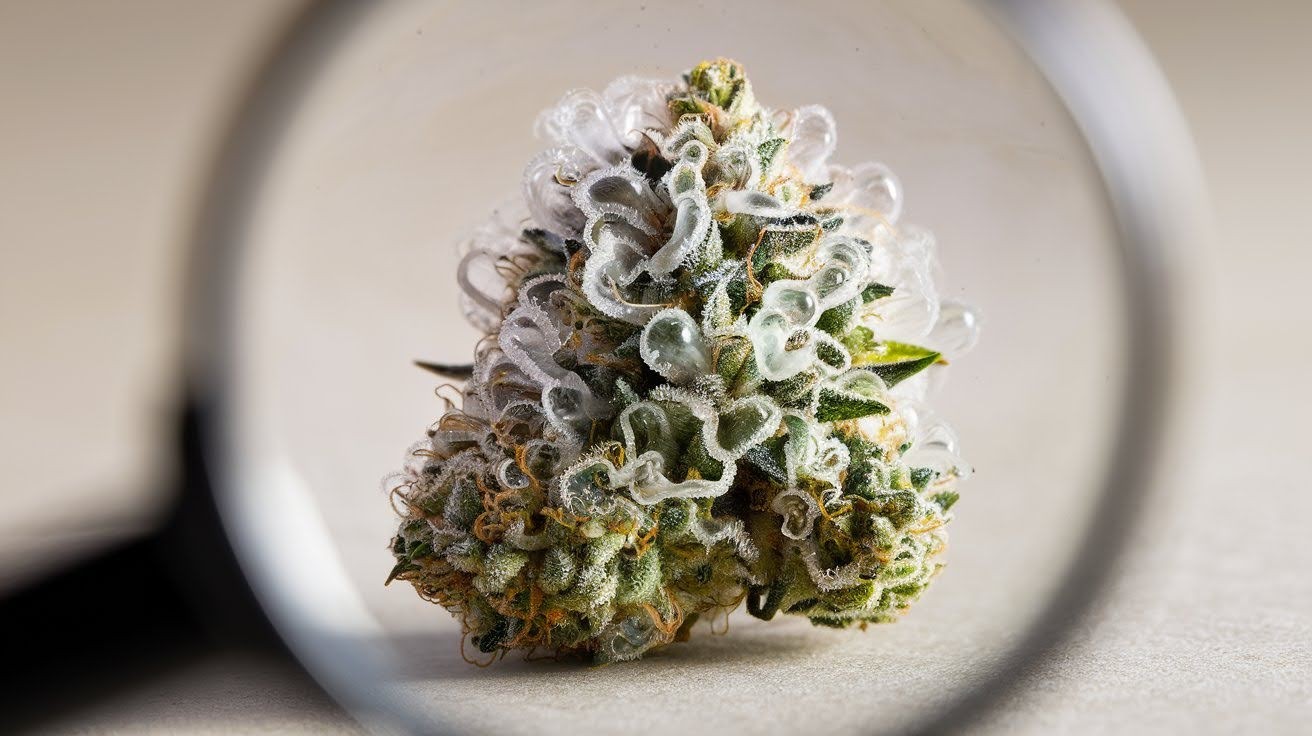
You know those sparkly bits that make good cannabis look like it’s covered in frost? Those aren’t crystals at all. They’re called trichomes.
I like to think of them as tiny factories. Each one produces and stores the compounds that get you high. THC and THCA live inside these small structures, along with other important molecules. Here’s why they matter so much:
Potency storage: More trichomes usually mean stronger effects Quality signals: Healthy plants produce more visible trichomes Effect indicators: Different trichome types create different experiences Cultivation clues: Well-grown cannabis shows better trichome development
But here’s something most people don’t know. Not all trichomes look the same. Some appear clear, others look milky white, and some turn amber. Each color tells you something different about the plant’s readiness and potential effects.
When I examine cannabis, the first thing I check is trichome coverage. Dense, frosty coating usually indicates careful growing and proper harvest timing. Sparse coverage often signals problems with the cultivation process.
You can see these structures without special equipment, but a basic magnifying glass helps you spot the details that matter.
Three Main Trichome Types as Quality Indicators
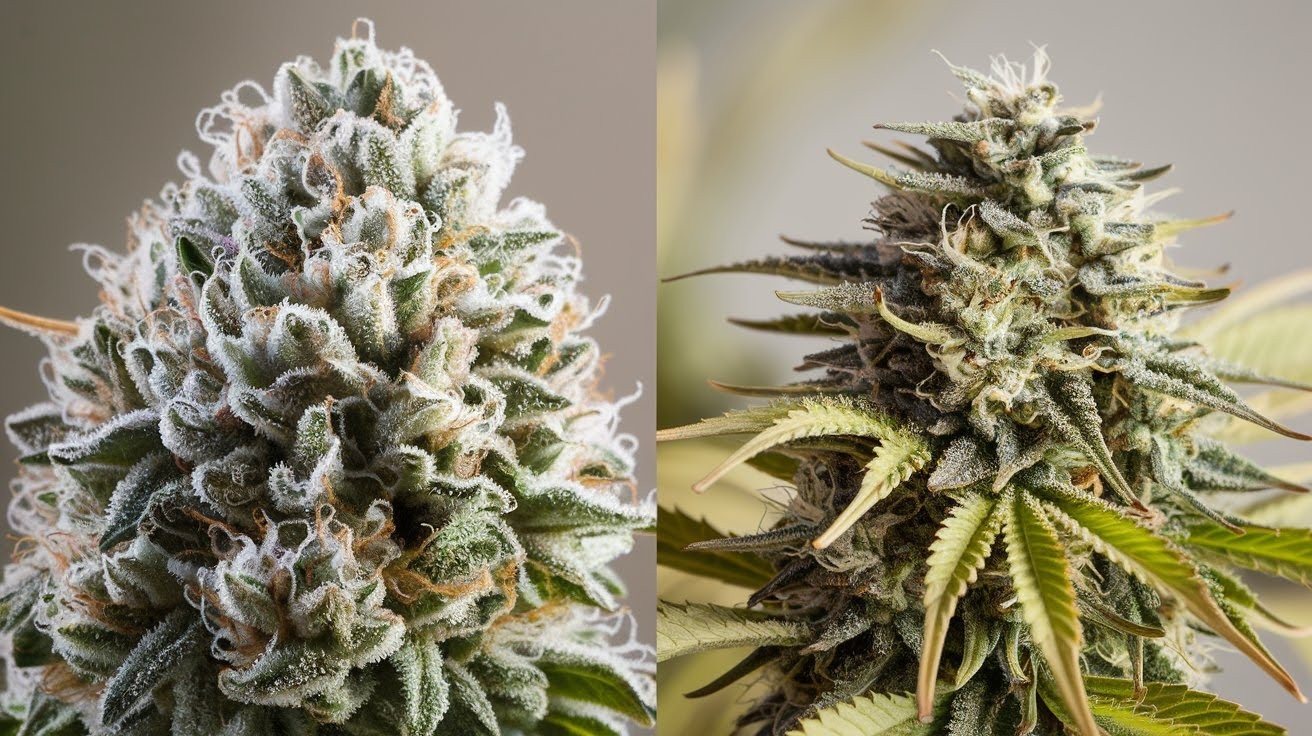
I need to tell you something important. Not all trichomes are created equal. There are three different types, and each one affects quality in its way.
Bulbous Trichomes are the tiny ones you barely notice. They measure only 10-15 micrometres, which is smaller than the width of human hair. These don’t pack much THC, but they do something else. They create a protective coating over the plant’s surface.
Think of them as the plant’s sunscreen. Capitate-Sessile Trichomes sit in the middle range at 20-30 microns. You’ll find moderate amounts of cannabinoids here, but their real job is different. These trichomes produce most of the smell and flavor you experience.
When do you catch that strong cannabis aroma? Thank these medium-sized workers. But here’s where quality shows up.
Capitate-Stalked Trichomes are the giants at 200-300 microns. I can spot these easily with just my eyes. They look like tiny mushrooms with clear stalks and round heads. These are your quality goldmine.
Here’s why they matter most:
- Highest THC concentration: Up to 10 times more than smaller types
- Visible quality markers: Easy to see and count
- Harvest timing indicators: Color changes show readiness
- Potency predictors: More stalked trichomes mean stronger effects
When I evaluate cannabis quality, I focus on these large trichomes first. Dense coverage of capitate-stalked trichomes tells me the grower knew what they were doing. The best buds show all three types working together, but those big stalked ones make the real difference.
Reading THC Crystal Appearance for Quality Assessment
THC crystals indicate potency and freshness. Their color, density, and sparkle help assess cannabis quality before purchase or consumption.
Crystal Color and Maturity Indicators

The color of trichomes tells you everything about timing and quality. Clear trichomes look like tiny glass beads. This means the plant is still growing. The THC hasn’t fully developed yet, so you’re looking at lower potency cannabis.
I always avoid buds with mostly clear trichomes. Milky white trichomes are what you want to see. This cloudy appearance means peak THC levels. The plant hit its sweet spot for potency and effects.
But wait too long, and things change. Amber trichomes signal trouble. The THC is breaking down into CBN, which makes you sleepy instead of high. This cannabis is past its prime.
Here’s the quality formula I use:
10% clear, 80% milky, 10% amber: This balance shows perfect harvest timing Mostly clear: Too early, weak effects Mostly amber: Too late, sedating effects All milky: Maximum potency potential
The color mix reveals whether the grower knew when to harvest. Good timing means better quality for you.
Crystal Density and Distribution Patterns
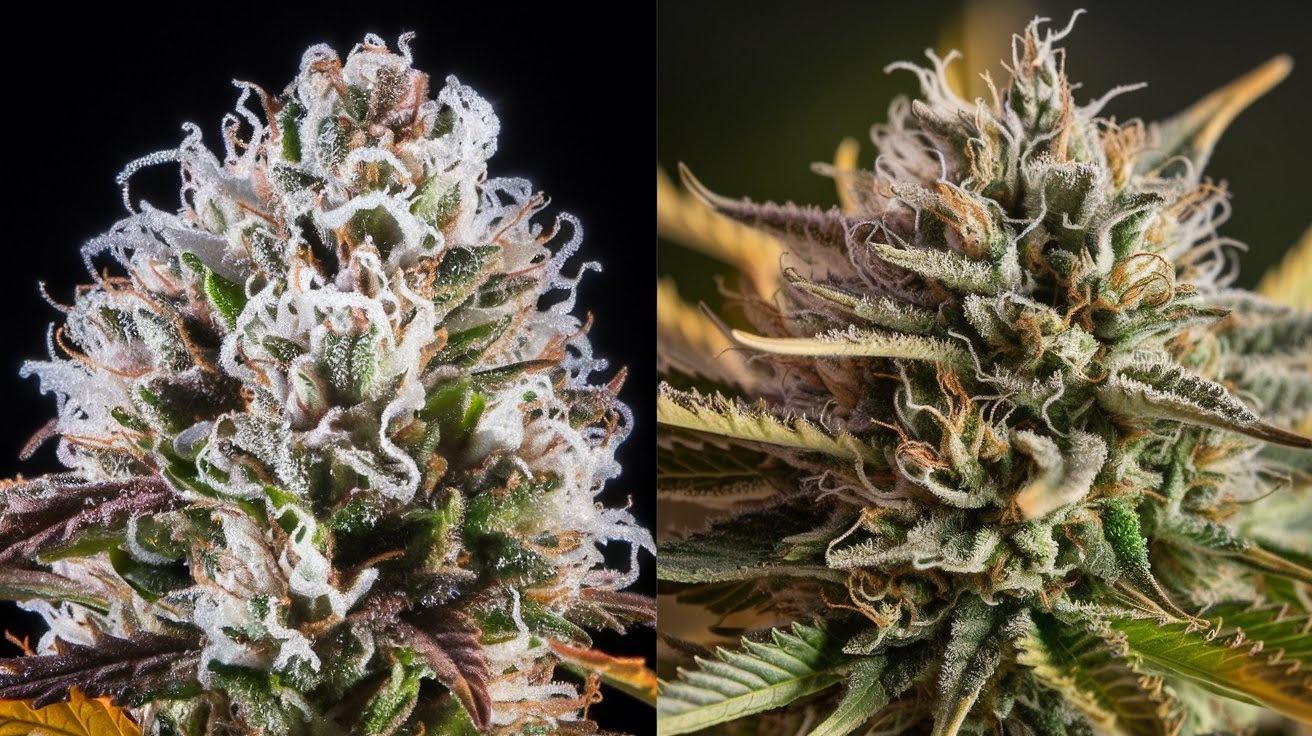
Density matters more than you think. When I examine quality cannabis, I look for thick crystal coverage. High-density trichomes show the grower did everything right. Good genetics, proper nutrients, and perfect timing all contribute to this frosty blanket.
Even distribution tells another story. Quality buds show crystals spread consistently across the entire surface. No bare spots or patchy areas. Poor cannabis looks different.
Sparse crystals reveal problems. Maybe the genetics were weak. Perhaps the growing conditions weren’t ideal. Either way, you’re looking at lower potency and reduced effects.
The thickness of that frosty coating directly relates to strength. More crystals mean more THC storage space.
Physical Characteristics Revealing Quality
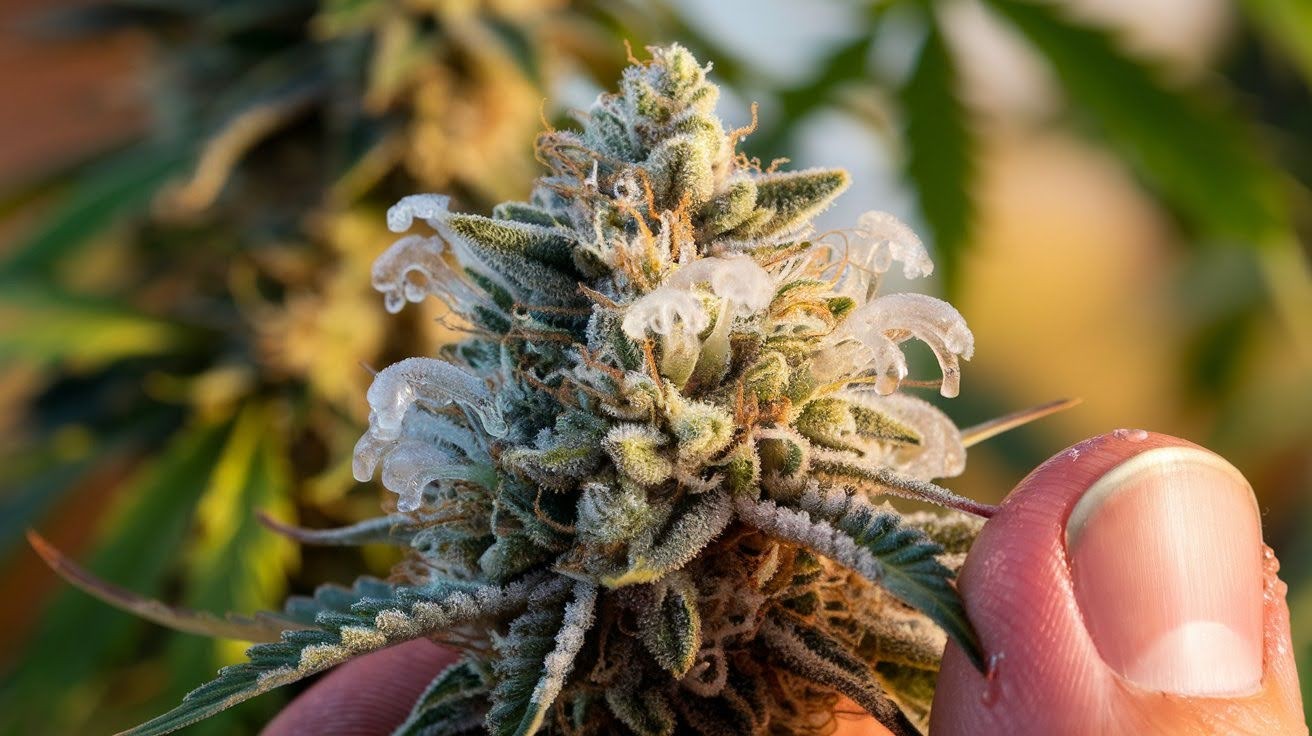
Touch reveals what your eyes might miss. Good cannabis feels sticky. That tackiness comes from high resin content in the trichomes. When you handle quality buds, they should leave residue on your fingers.
But don’t just touch, look closely under the light. Quality trichomes sparkle like tiny diamonds. This isn’t just pretty to look at. That sparkling effect shows abundant, healthy trichomes reflecting light off their surfaces.
Here’s what else to check:
- Crystal integrity: Intact trichomes mean careful handling
- Visible stalks and heads: You should see the mushroom shape clearly
- No broken or missing crystals: Shows proper storage and transport
- Damaged trichomes look dull and broken. This happens with rough handling or poor storage conditions.
When everything looks right-dense, even, intact, and sparkling, you’ve found quality cannabis.
What Crystal Characteristics Tell You About Potency
Crystal size, clarity, and density offer clues about THC potency. Rich, sticky trichomes usually signal stronger, high-quality cannabis buds.
Direct Potency Correlation
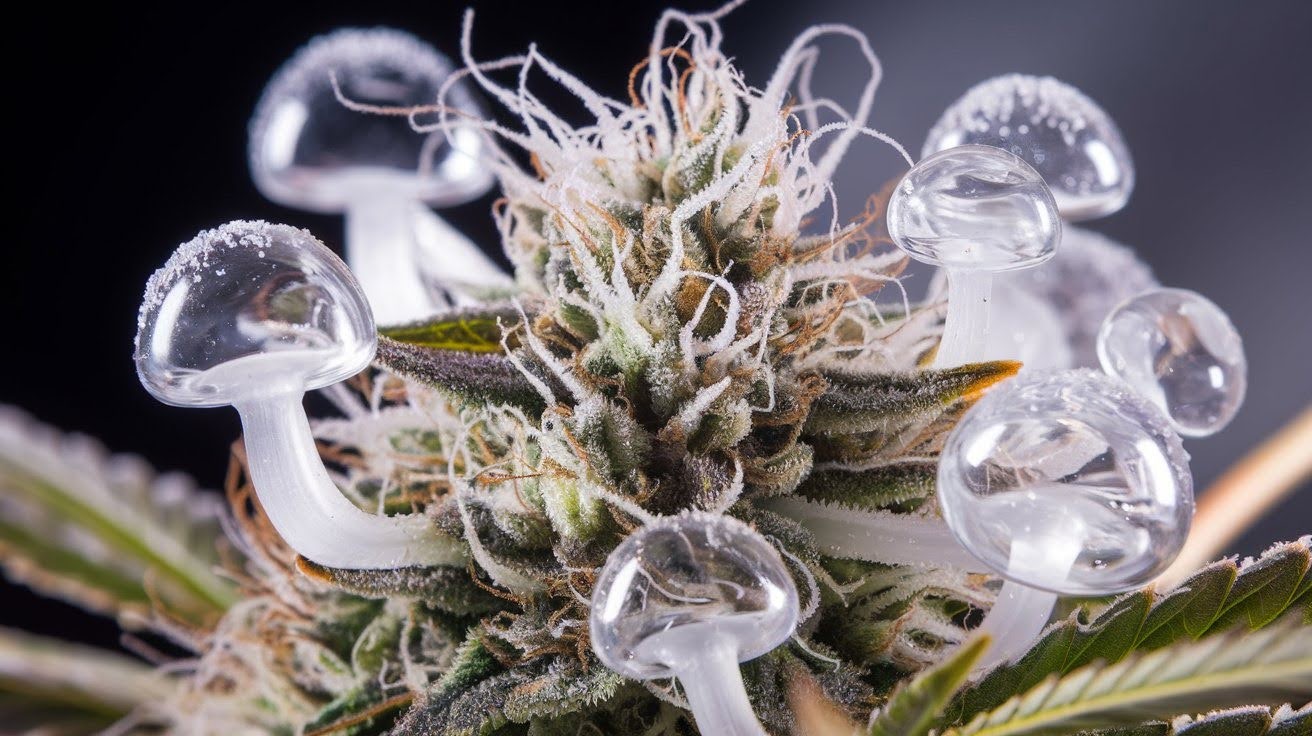
More crystals usually mean stronger effects. I’ve tested this connection countless times. When you see dense trichome coverage, you’re looking at higher psychoactive potential. It’s that simple.
But here’s the key detail most people miss. Capitate-stalked trichomes are your real strength indicator. These large, mushroom-shaped crystals hold the most THC. Count these specifically, not just overall crystal coverage.
However, visual assessment has limits. What you see doesn’t always match lab results. Some strains naturally produce fewer visible trichomes but still test high for THC. Others look frosty but deliver weaker effects.
Still, there’s a pattern I’ve noticed:
- Crystal-rich buds consistently rank higher in consumer preference
- Dense coverage correlates with stronger reported effects
- Visible trichomes serve as reliable initial quality filters
The relationship isn’t perfect, but it’s strong enough to guide your choices. When you see thick, healthy crystal coverage, you’re more likely to get potent cannabis. Trust your eyes as a starting point, but remember that genetics and growing methods matter too.
Terpene Content Indicators
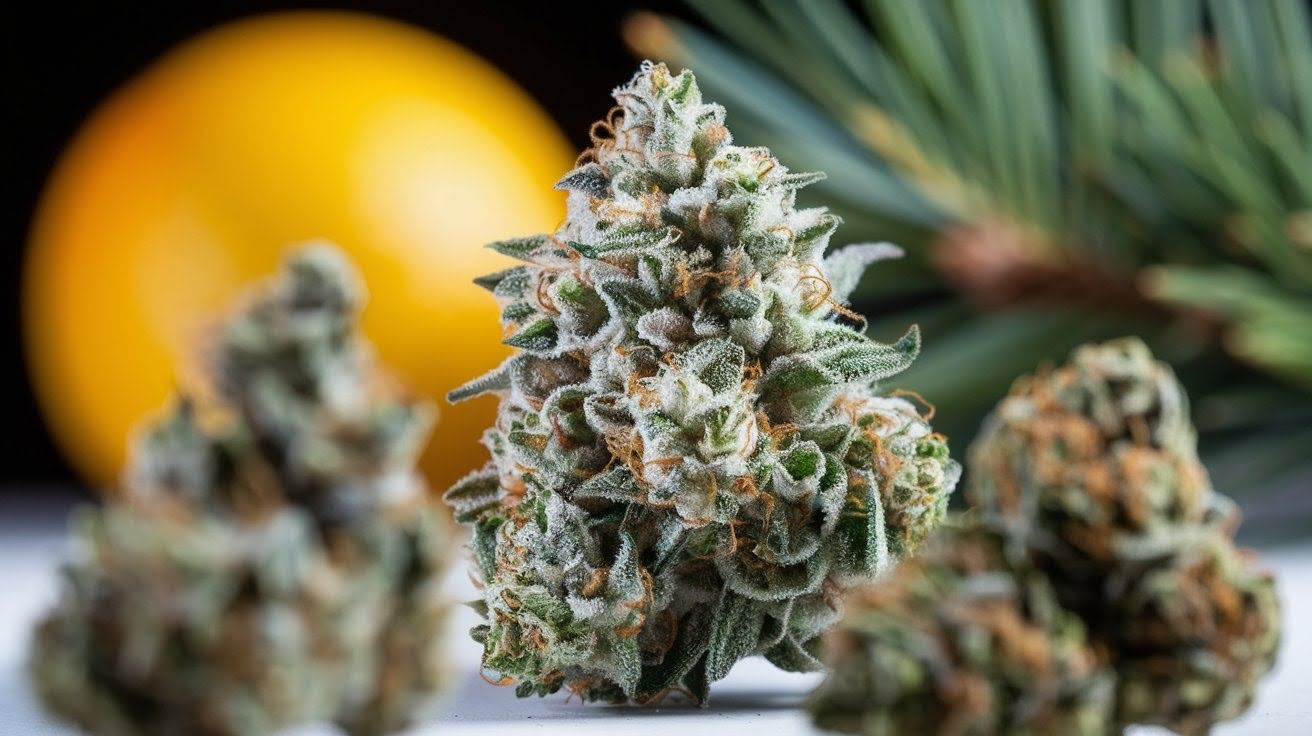
Crystals don’t just hold THC. They’re also packed with terpenes, the compounds that create smell and flavor. When I see abundant crystals, I expect stronger aromas too. Here’s what I’ve learned from years of testing.
Healthy trichomes produce better flavors. Damaged or degraded crystals lose their terpene content first. That’s why proper handling matters so much. Different strains show unique patterns.
Citrus strains often display smaller, denser crystal clusters. Pine-scented varieties tend to have larger, more spread-out trichomes. Fruity strains usually show medium-sized crystals with excellent clarity. But there’s something bigger happening here.
The combination effect between THC and terpenes creates your overall experience. More crystals mean more of both compounds working together. Signs of good terpene potential:
Strong aroma when you smell the bud Intact crystal structure showing no damage Proper color balance indicating fresh terpenes
When crystals look healthy and abundant, you’re likely getting full-spectrum effects, not just THC alone.
Professional Quality Assessment Techniques
Showcase expert methods for judging cannabis quality-microscope use, trichome inspection, aroma analysis, and texture testing for accurate results.
Magnification Methods for Accurate Assessment
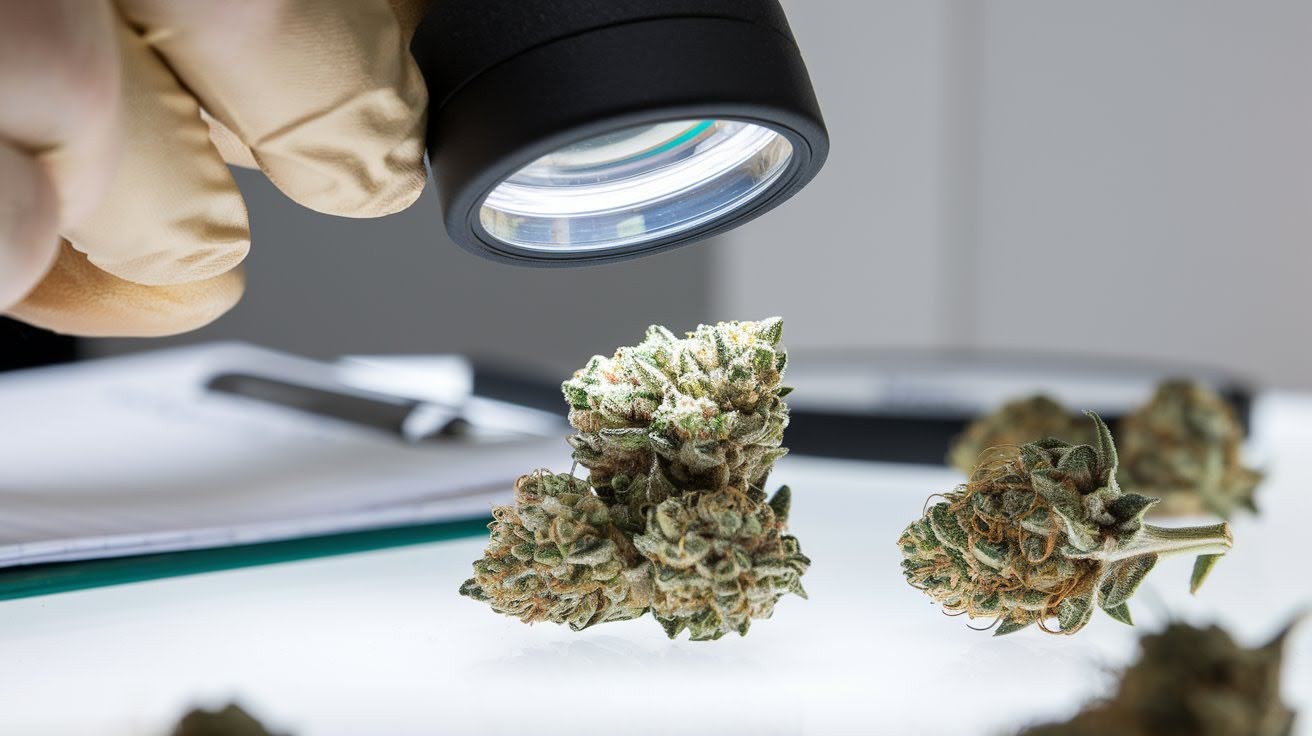
Your naked eye only tells part of the story. I always use a magnifying lens for serious quality checks. A simple 10x magnifier shows details you’d never catch otherwise. You can see individual trichome heads, check for damage, and spot color variations.
Here’s my inspection process:
- Look for mushroom shapes: Healthy trichomes have clear stalks and round heads
- Check color distribution: Peak potency shows mostly milky white crystals
- Count intact structures: Broken trichomes mean handling problems
Professional graders use these same visual cues. Lab testing often matches what trained eyes can see. When I spot dense, healthy crystals, lab results usually confirm high THC levels. But there’s a gap most people don’t know about.
Quality Standards and Benchmarks

The industry uses specific crystal coverage standards. Premium-grade cannabis needs 70% or higher crystal coverage across the bud surface. Mid-grade falls between 40-70%. Anything below 40% gets classified as lower quality. I teach consumers to recognize these levels:
- Top shelf: Dense, even crystal coating
- Mid-grade: Moderate coverage with some bare spots
- Budget tier: Sparse crystals, mostly on sugar leaves
Professional assessment considers crystal integrity, density, and color balance together. Markets use these criteria to set pricing and quality ratings. Visual assessment works when you know what to look for.
Common Quality Issues Revealed by Crystal Examination
Crystal inspection can reveal issues like premature harvest, poor curing, contamination, or low potency in cannabis buds through visual clues.
Signs of Poor Quality or Damage
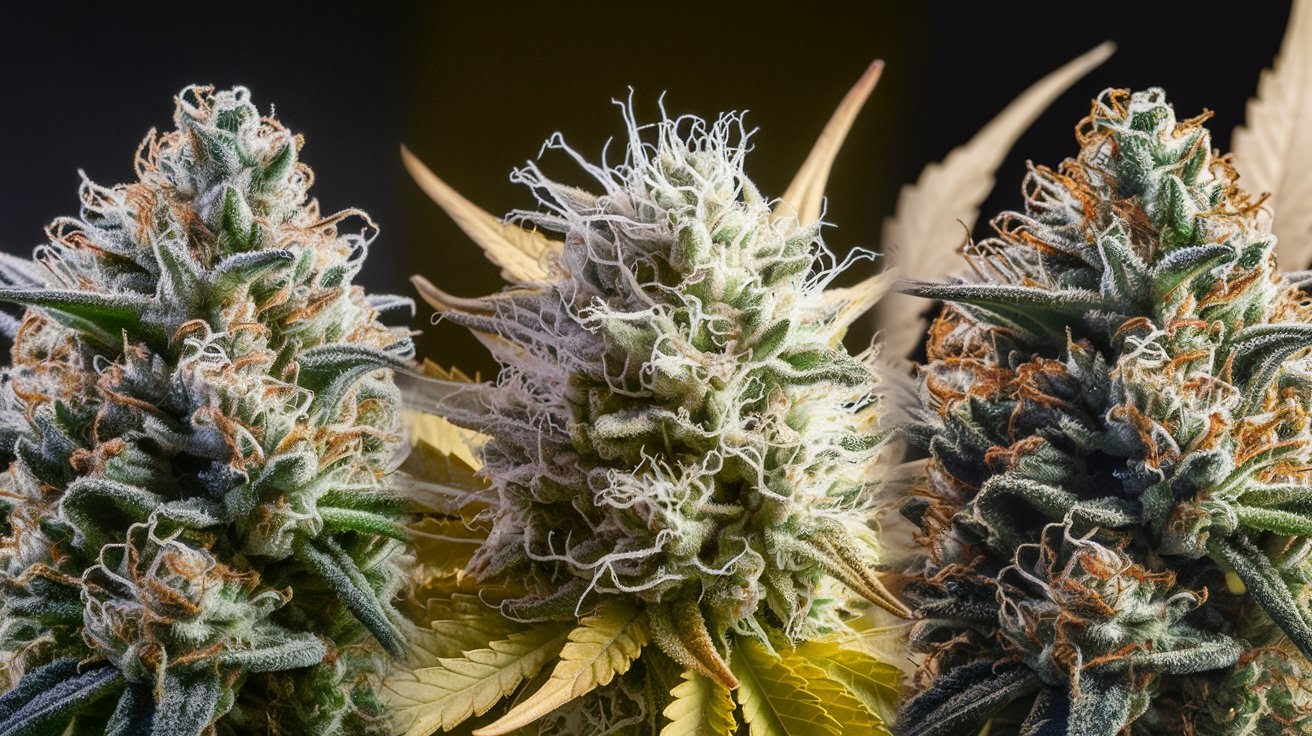
Bad cannabis shows obvious crystal problems. When I see minimal crystal coverage, I know something went wrong. Either the genetics were poor, or the growing conditions failed. Quality plants produce abundant trichomes naturally.
Broken trichomes tell a different story. These look like tiny stumps where crystal heads should be. Rough handling during harvest, trimming, or transport causes this damage. You lose potency when trichome heads break off.
Discolored crystals raise red flags immediately. Healthy trichomes look clear, milky, or amber. Brown, black, or gray crystals signal contamination or severe degradation. This cannabis isn’t safe to use.
Patchy distribution reveals cultivation issues. Good growers produce even crystal coverage across the entire bud surface.
Environmental Damage Indicators
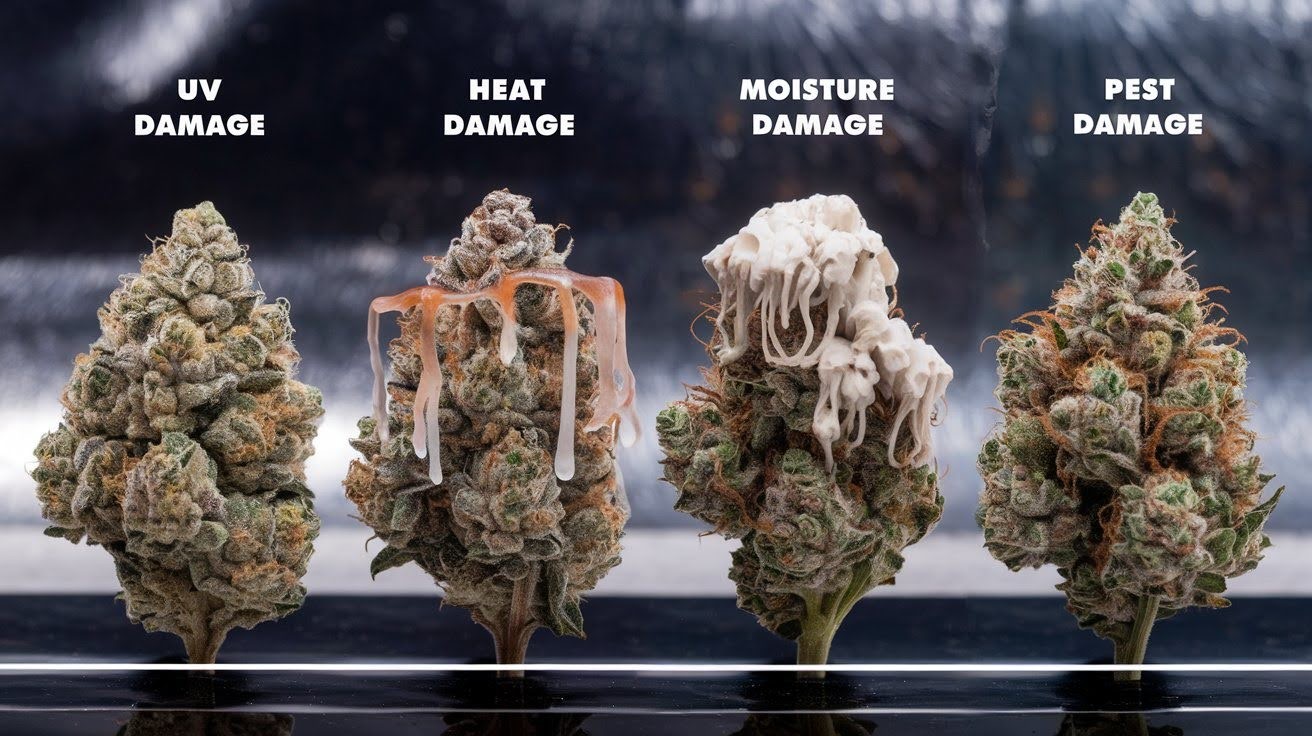
Light, heat, and moisture destroy crystal quality. UV damage makes crystals look dull and lifeless. They lose their sparkle and turn yellowish. Heat damage causes crystals to appear melted or collapsed.
Moisture problems create different issues:
- Mold growth around crystal areas
- Soggy-looking trichomes that lack structure
- Missing crystals where water washed them away
Pest damage shows up as bite marks or missing crystal patches where insects are fed. When you spot any of these problems, avoid cannabis completely.
Conclusion
Now you know exactly what THC crystals on bud are telling you about quality. Those tiny trichomes aren’t just pretty decorations they’re your guide to potency, freshness, and overall cannabis quality. You’re equipped to make smarter choices now. Look for dense, milky-white crystal coverage with intact mushroom shapes.
Avoid buds with broken, discolored, or sparse trichomes. Remember, healthy crystals mean quality cannabis. The visual clues we covered will help you spot premium products and avoid disappointing purchases. Your next dispensary trip will be completely different.
You’ll know what to look for and feel confident in your selections. What’s your experience been with crystal-covered buds? Share your thoughts in the comments below. I’d love to hear about your quality discoveries.
Frequently Asked Questions
What are THC crystals on bud?
THC crystals are trichomes, tiny, frosty structures on cannabis buds that contain THC and other compounds. They look like sparkly crystals but are natural resin glands.
Do more crystals mean stronger weed?
Generally yes. Higher crystal density usually indicates more THC content, but genetics and growing methods also matter. Look for dense, intact trichome coverage.
What color should quality THC crystals be?
Quality crystals appear milky white at peak potency. Clear crystals indicate immaturity, while amber crystals show THC has degraded into CBN.
How can I tell if crystals are damaged?
Damaged crystals look broken, dull, or missing their mushroom-shaped heads. Quality crystals should be intact, sparkling, and evenly distributed across the bud.
Can I see THC crystals without a magnifying glass?
Yes, quality cannabis shows visible crystal coverage to the naked eye. However, a simple magnifying lens helps you examine individual trichome health and color.



